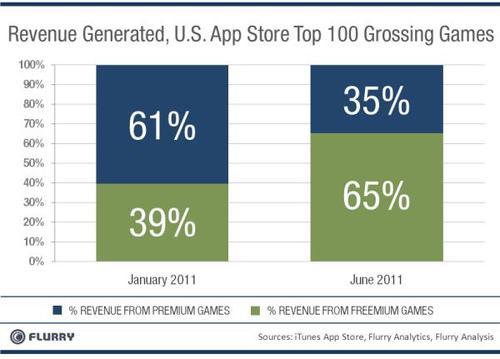To free, or not to free
Among the most common questions we get from game developers is whether the free-to-play (a.k.a. freemium) model makes sense for their next game. For teams that have always charged players up-front with a premium pricing model, the thought of distributing games for free makes them very uncomfortable. I made the switch myself when I joined a free-to-play social games startup as a Studio Director in 2009, so I’m well aware of both the anxiety and the opportunity.
To best answer this question, I decided we should do it the Flurry way: with hard data. To do so, we compared the revenue generated by pricing model, freemium vs. premium, among the top 100 grossing games in January and June of this year. Premium simply means charging for the download (e.g., $0.99). Freemium describes the free-to-play model, where the game is given away for free, and then the consumer can purchase virtual currency and/or virtual goods through in-app-purchases. Tracking over 90,000 apps with its analytics service, Flurry can measure the amount of revenue generated per ranked position in the App Store top grossing category. The chart below compares the proportion of revenue generated by each model.

Inspecting the chart, we see that free games already represented 39% of the games revenue generated by Apple’s App Store in January, but that number has since risen to 65% last month. The traction of the freemium business model is undeniable and growing fast. In fact, with games often occupying more than 75% of all top 100 grossing apps in the app store, it’s the single most dominating business model in the mobile apps industry today.
In the old paid world of video games, success was measured by multiplying the number of units sold by the unit price, the traditional retail model. In the new world of digital games distribution, it’s all about how many players you can keep engaged with your free game, followed by how many compelling spending opportunities you can provide them.
When you make your game free and add in-app purchases, two powerful things can happen: first, more people will likely try your game since you’ve made the “ante” zero; and second, you will likely take more total money, since different players can now spend different amounts depending on their engagement and preferences. It’s not unheard of for individual players to spend into the tens of thousands in a game they like.
Flurry data shows that the number of people who spend money in a free game ranges from 0.5% to 6% depending on the quality of the game and its core mechanics. Although this means that more than 90% of players will not spend a single penny, it also means that players who love your game spend much more than the $0.99 you were considering charging for the app. And since you gave away the game for free, your “heavy spender” group can be sizable.
Free-to-play is here to stay. If you’re a game studio, you simply need to understand how to take advantage of this game-changing opportunity. In future posts, I’ll cover strategies and tactics you can employ to make this powerful model work best for you.